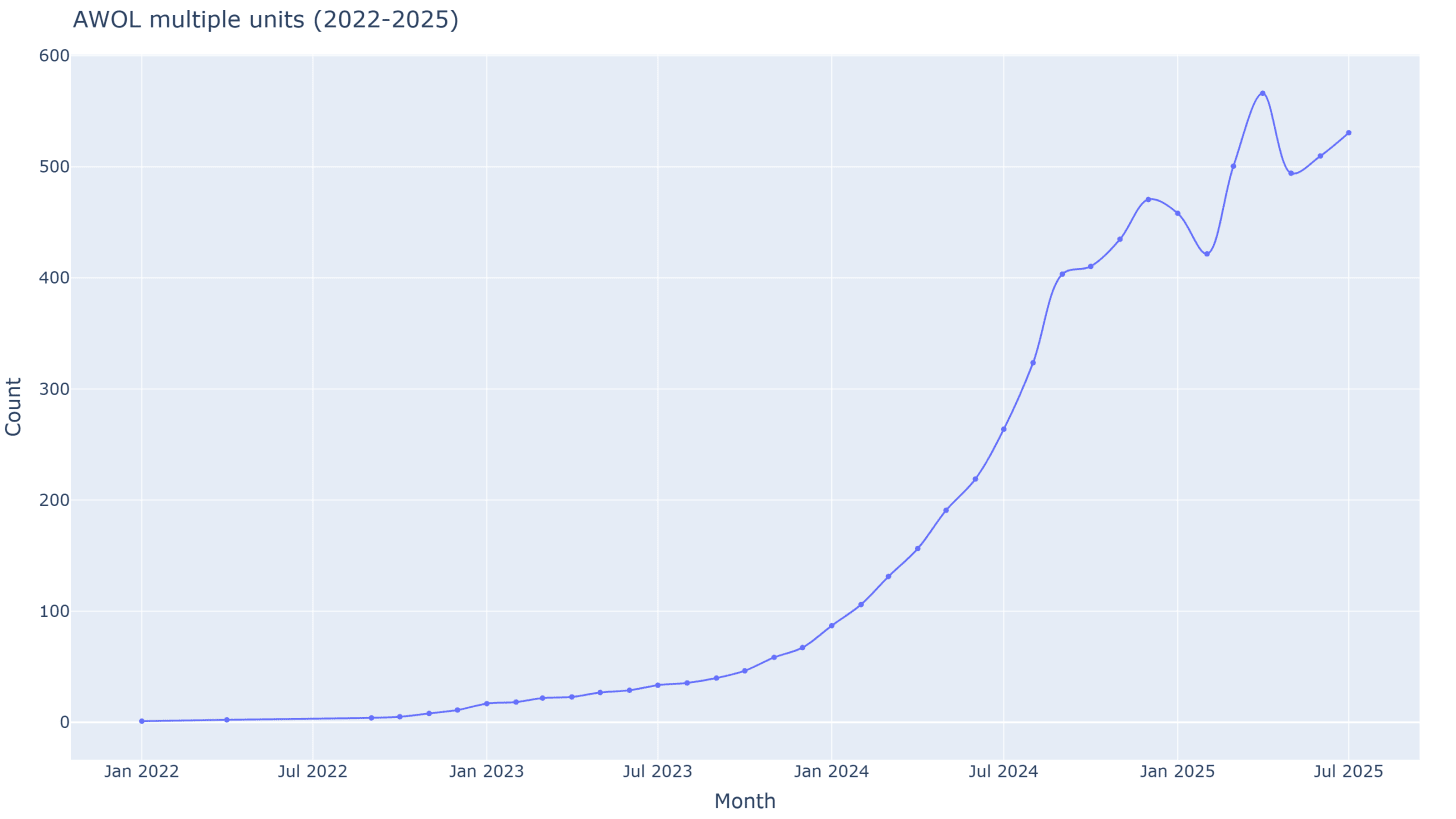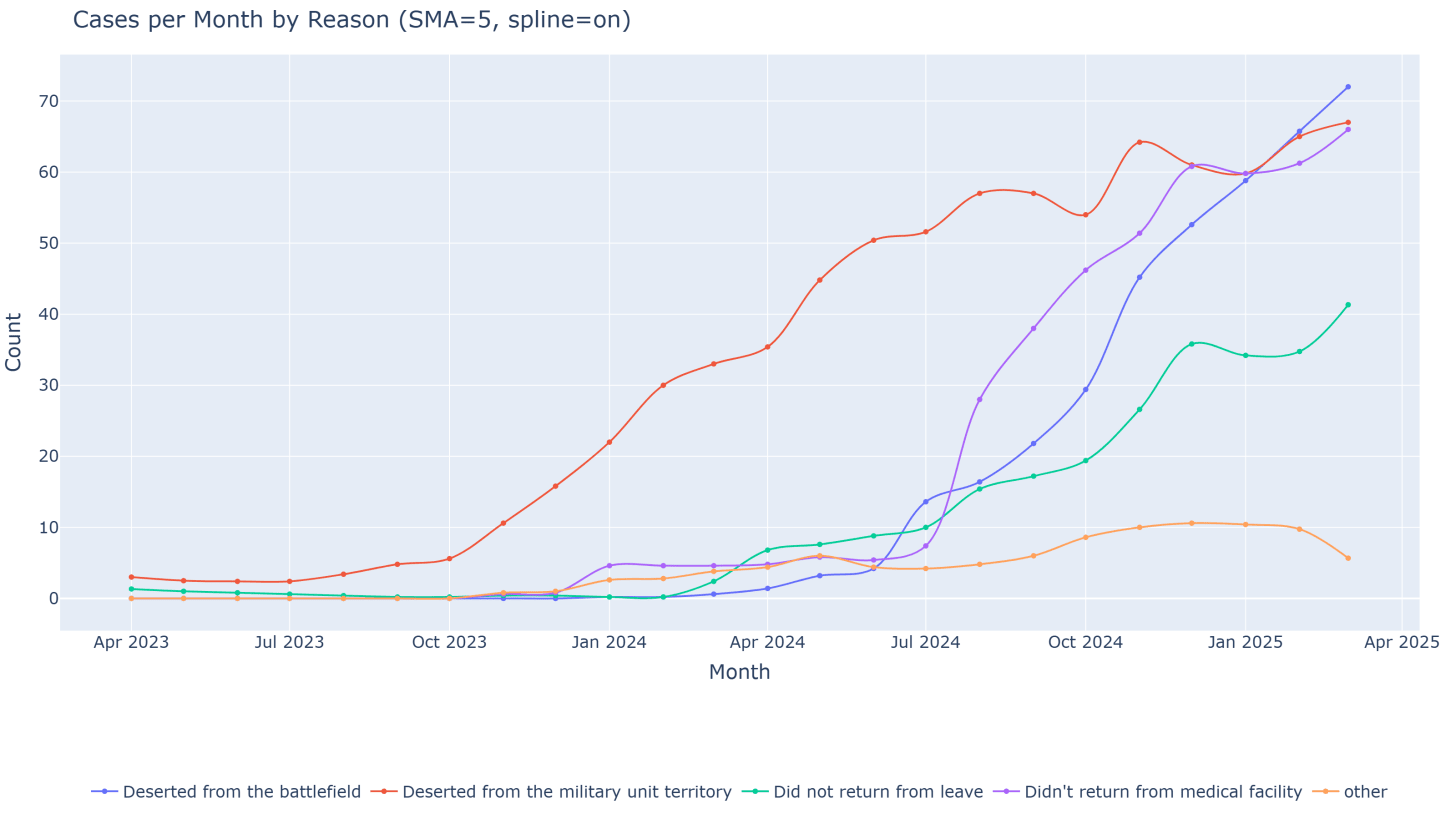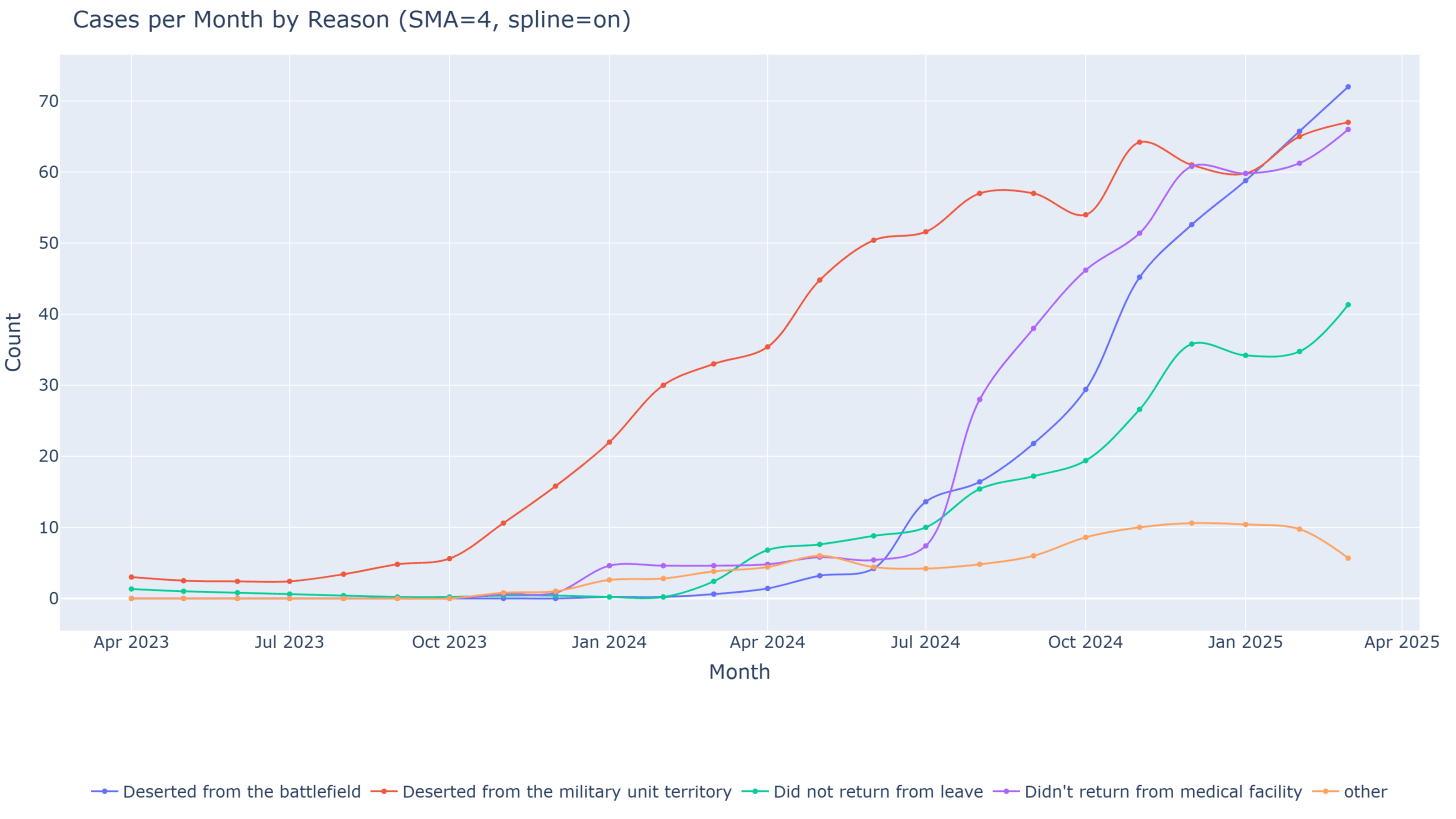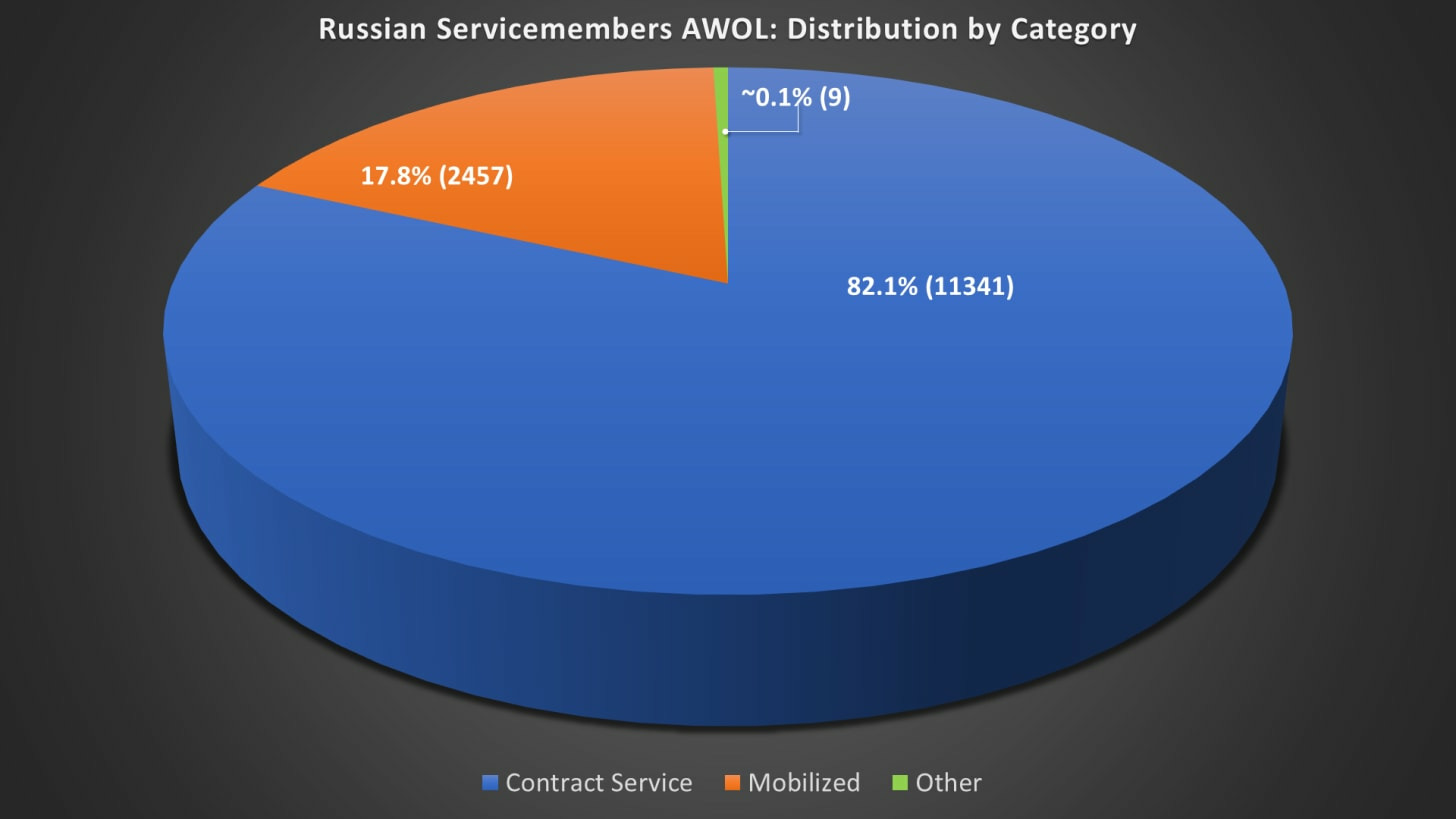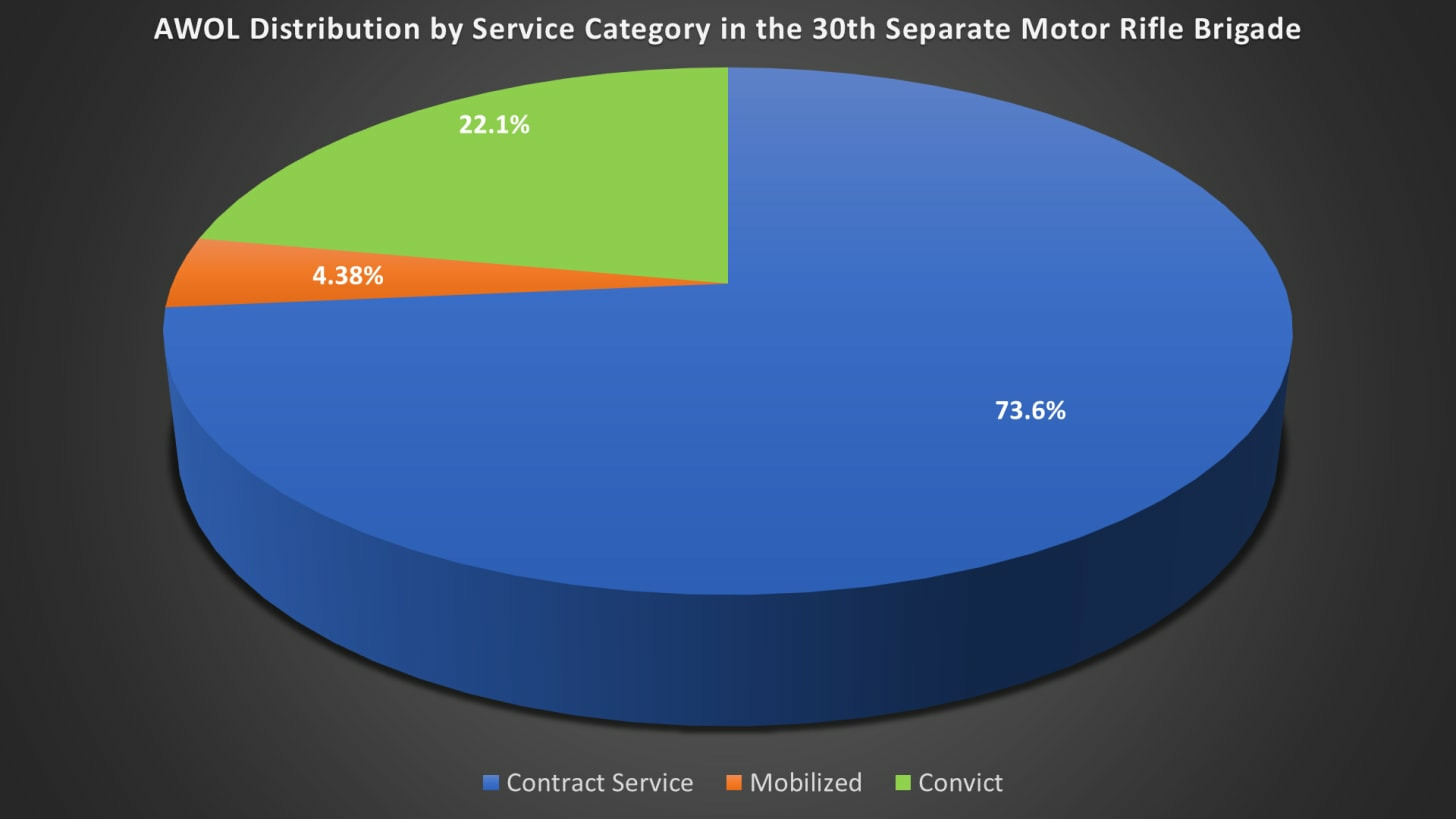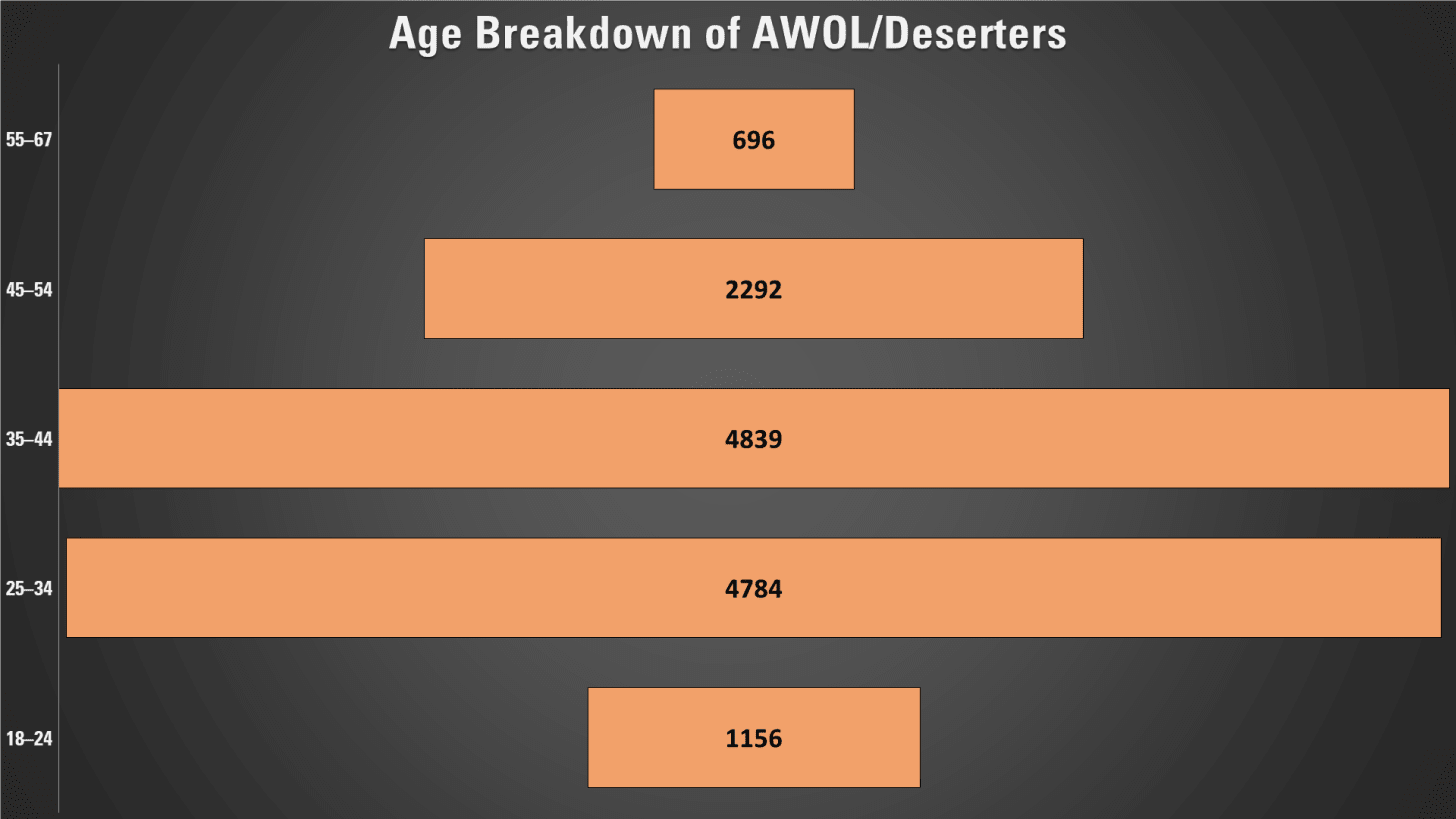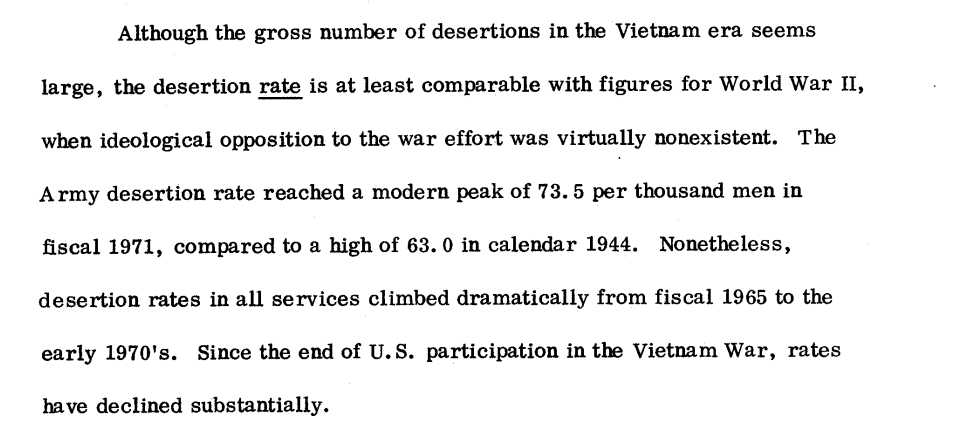
Our research, based on tens of thousands of personal records, shows that the typical deserter in the Russian army is a 37-year-old male under contract, and that his chance of desertion in 2025 doubled compared with 2024. If the desertion trend continues, we estimate at least 70,000 deserters in the Russian army this year - roughly 10% of the entire force deployed in Ukraine. In some units heavily engaged in combat operations in Donetsk Oblast, the monthly rate of battlefield desertions rose nearly tenfold in the first half of 2025.
Despite the rising numbers, Russia has so far built a relatively effective system for tracking down and returning deserters. However, this system will be severely tested as cases continue to grow, and bringing back such large numbers will become increasingly difficult.
Table of Contents:
Intro
I. Understanding the Terms
II. Data and Trends, 2022 - 2025
III. Profile of the deserter: demographics and recruitment
IV. Paths of Desertion
V. Enforcement and Returns
VI. Lessons from Past Wars
a) Vietnam War
b) World War I: Eastern Front
To identify trends and draw conclusions, we analyzed tens of thousands of Russian records provided by the Ukrainian project I Want to Live, as well as internal documents from various Russian units, including, but not limited to, the 2nd Motor Rifle Division, 30th Motor Rifle Brigade, 291st Motor Rifle Regiment, 144th Separate Motor Rifle Brigade, 1st Tank Army, and elements of the 58th Army.
This Substack is reader-supported. To receive new posts and support my work, consider becoming a free or paid subscriber.
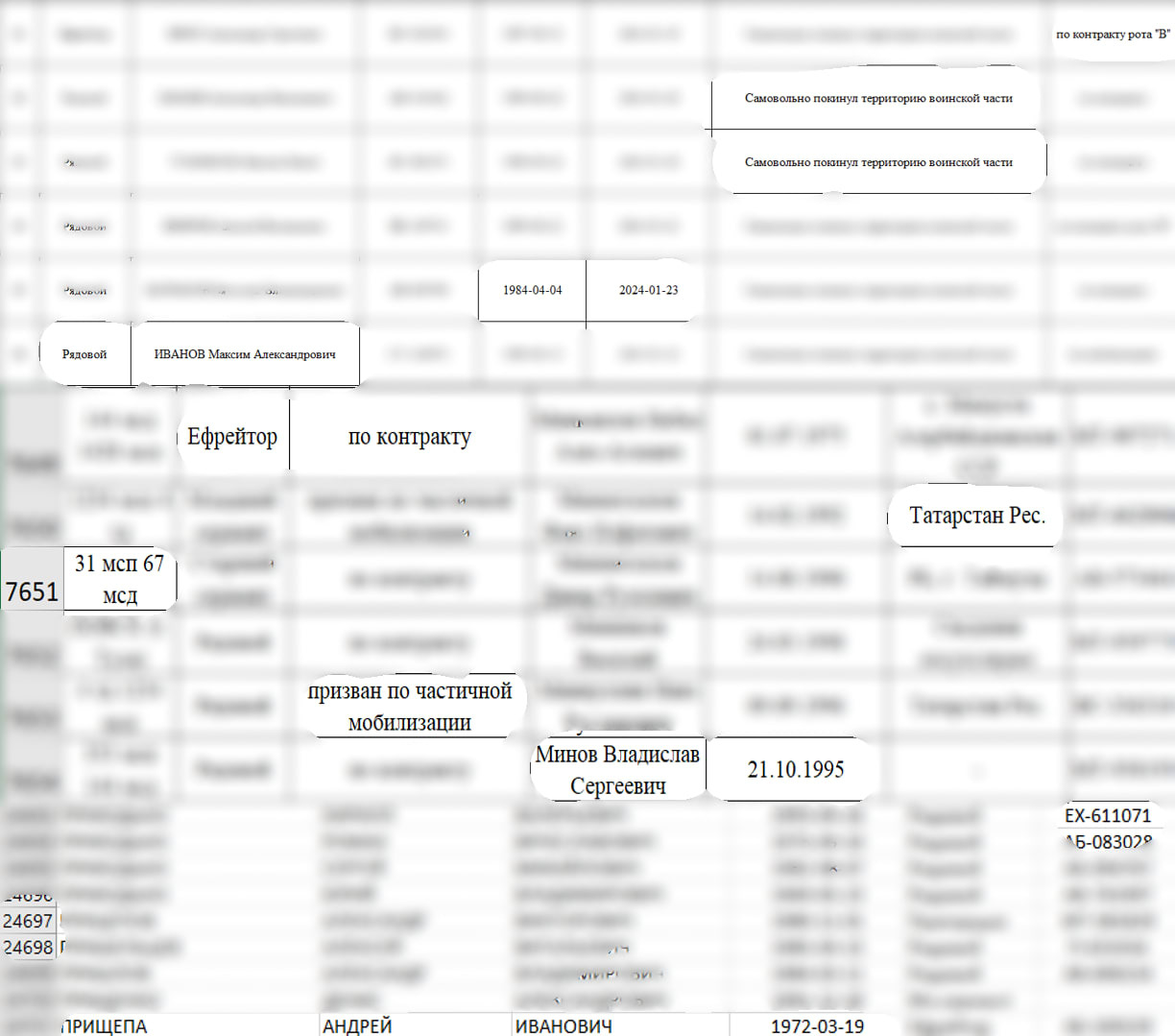
While we place considerable trust in the I Want to Live project, we conducted our own verification. Our team randomly selected 21 cases from the spreadsheet and cross-checked each soldier’s name, date of birth, and address using third-party services. Nineteen cases matched perfectly; the two discrepancies involved addresses, likely reflecting pre-war records that had not been updated. Overall, the spreadsheet appears authentic.
I. Understanding the Terms
Before looking at desertion and AWOL figures, it’s important to clarify how the terms are defined, as they differ across countries. Under Russian law, the distinction depends on both duration and intent. Short absences are usually treated as disciplinary matters. Absences of more than two days but less than ten can still lead to disciplinary action, such as arrest or reprimand. Once an absence lasts more than ten days, it falls under Article 337 of the Russian Criminal Code and becomes a criminal offense, punishable by imprisonment.
Desertion is closely related to AWOL but is defined by intent. If a soldier leaves with the purpose of evading service altogether, the case is classified as desertion under Article 338, which carries harsher penalties.
For this analysis, we focus only on cases that amount to criminal liability, not minor disciplinary violations such as being late by a day after leave. Throughout the report, the terms AWOL and desertion are used interchangeably, since they differ mainly in intent - a distinction that matters in court but less so when analyzing the broader dynamics of the war.
II. Data and Trends, 2022 - 2025
One document, listing 13,807 AWOL cases by name and unit from 2022 through July 2025, shows that by summer 2025, monthly cases were nearly six times higher than in January 2024. AWOL and desertion rose steadily through 2024, and although there was a brief slowdown in early 2025, the numbers soon climbed again. The apparent drop in July 2025 reflects incomplete data, as the file covered only part of the month and cases are often recorded as AWOL only after a delay.
More strikingly, the annual AWOL and desertion rate appears to have doubled. In 2024, there were 3,196 cases out of 13,807 records, while from January through the partial month of July 2025, 3,408 cases were already recorded.
Internal records from individual units also confirm the doubling of desertion rates. One example comes from the 30th Separate Guards Motor Rifle Brigade of the 2nd Combined Arms Army. A unit document, covering 1,988 individual cases between April 2023 and March 2025, tracks desertions in detail and sheds light on the circumstances. The overall trend mirrors the broader combined dataset - average monthly cases rose about sixfold between early 2024 and 2025. Annual trend look even more severe: in 2024, there were 1,189 AWOL and desertion cases, while in just the first three months of 2025 more than 756 had already been recorded.
To put the scale in perspective at the level of an individual brigade: a Russian motor rifle brigade currently has between 3,000 and 3,800 personnel, depending on how fully staffed it is. Over 23 months, AWOL cases amounted to roughly half the strength of a full brigade. As noted, in just the first three months of 2025, 756 servicemembers had already deserted - equivalent to about 20% of a fully staffed brigade.
Based on the records, we grouped desertions into several categories: leaving the battlefield, leaving the unit’s grounds, failing to return from leave, failing to return from a medical facility, and other causes. The graph shows that while most desertions initially occurred from military bases, by 2025 an increasing number of servicemembers were leaving the battlefield or failing to return from medical facilities. This trend in battlefield desertions is a significant development, which we will revisit later.
III. Profile of the deserter: demographics and recruitment
Of the 13,807 AWOL cases recorded in the first document, 11,341 involved contract soldiers, 2,457 involved mobilised personnel, and 9 fell into other categories, such as conscripts. Because contract soldiers make up a far larger share of the force, it is unsurprising that most desertions occurred among them.
At the unit level, the pattern is similar. In the 30th Separate Brigade, 1,988 desertions were recorded, with contract soldiers making up the majority at 73.6%. The main difference from other units is the unusually high share of former convicts recruited from prisons: 22.1%, meaning roughly one in five deserters came from this group.
Demographically, the average age of a deserter is 37. The largest age group is 35–44, followed by 25–34. This likely reflects the overall makeup of the Russian army, consistent with our previous findings.
IV. Paths of Desertion
While our team has identified the most common methods of desertion, specific details remain limited. Drawing on hundreds of anecdotes and prior reports, including one from Mediazona, we have categorised the main methods as follows:
Leaving the military base before deployment to Ukraine. This is a common method, as it allows soldiers to escape within Russian territory without crossing borders or bypassing multiple checkpoints. It can occur during rotation, training, or the pre-deployment period.
Failing to return from leave. One of the easiest methods, this allows a soldier to leave their the war zone legally and cross the border. However, it does not work for everyone: certain groups, such as former prisoners, often do not receive official leave.
Leaving the hospital. Soldiers evacuated to hospitals in Russia, such as those in Rostov or Belgorod, sometimes use this opportunity to desert. This method is less viable when soldiers are sent to hospitals in occupied territories. Security measures vary: some hospitals actively prevent desertions, while others make little effort.
Escaping from the combat zone. This method has grown more common in 2025, despite being difficult. To reach the Russian border, soldiers must bypass multiple checkpoints and avoid drawing attention from units performing military-police or administrative duties in the occupied area. After reaching the border, they still need to cross from occupied territory into Russia. In some regions that crossing is relatively easy; in others it requires local knowledge of weak points in the border.
Using forged leave papers or bribery near the front. Some soldiers desert from temporary bases or positions close to the front not by crossing the border on their own, but by making fake leave documents or paying off people on checkpoints. We lack hard statistics on these cases, but multiple anecdotes describe soldiers presenting forged papers that border guards or checkpoint personnel either fail to check closely or cannot quickly verify.
V. Enforcement and Returns
To address the growing problem, Russian forces have been developing and expanding various methods to prevent desertion, minimize its impact, and return deserters.
Russian forces use a range of measures to prevent desertion, combining legal and administrative controls with harsher extrajudicial punishments. In rear areas, checkpoints, and border zones, authorities increase policing and oversight, while some units reportedly employ physical torture, maiming, and both mock and real executions. In several cases, soldiers who deserted from the battlefield were captured and executed by their own units, yet officially remained listed as deserters. This ensures that their families cannot receive state benefits and serves as a warning that desertion carries consequences for both the individual and their relatives.
Despite these severe measures, the number of soldiers successfully escaping has continued to grow. To counter this, military units work closely with law enforcement to locate deserters at their last known addresses and return them. Depending on the situation, soldiers may be sent back to their original units, usually to high-risk assault units, where survival chances are low.
The effectiveness of returning deserters varies across units, but some have been notably successful. Internal documents from the 144th Separate Motor Rifle Brigade, for example, show that out of 1,430 desertions recorded between March 2022 and March 2025, 1,174 servicemembers had been detained and returned, while 256 were still being actively searched for, representing an 82% success rate.
VI. Lessons from Past Wars
For military analysts, the challenge isn’t just gathering and analyzing data, it’s interpreting what the numbers actually mean. In practical terms, the question is simple: what do these figures tell us about the Russian army? Are its forces on the brink of collapse, or is this within the range of normal operational strain?
There’s no single threshold at which an army automatically falls apart. But by comparing current trends with historical cases, analysts can gain a clearer sense of the broader picture and assess how serious the situation might be.
a) Vietnam War
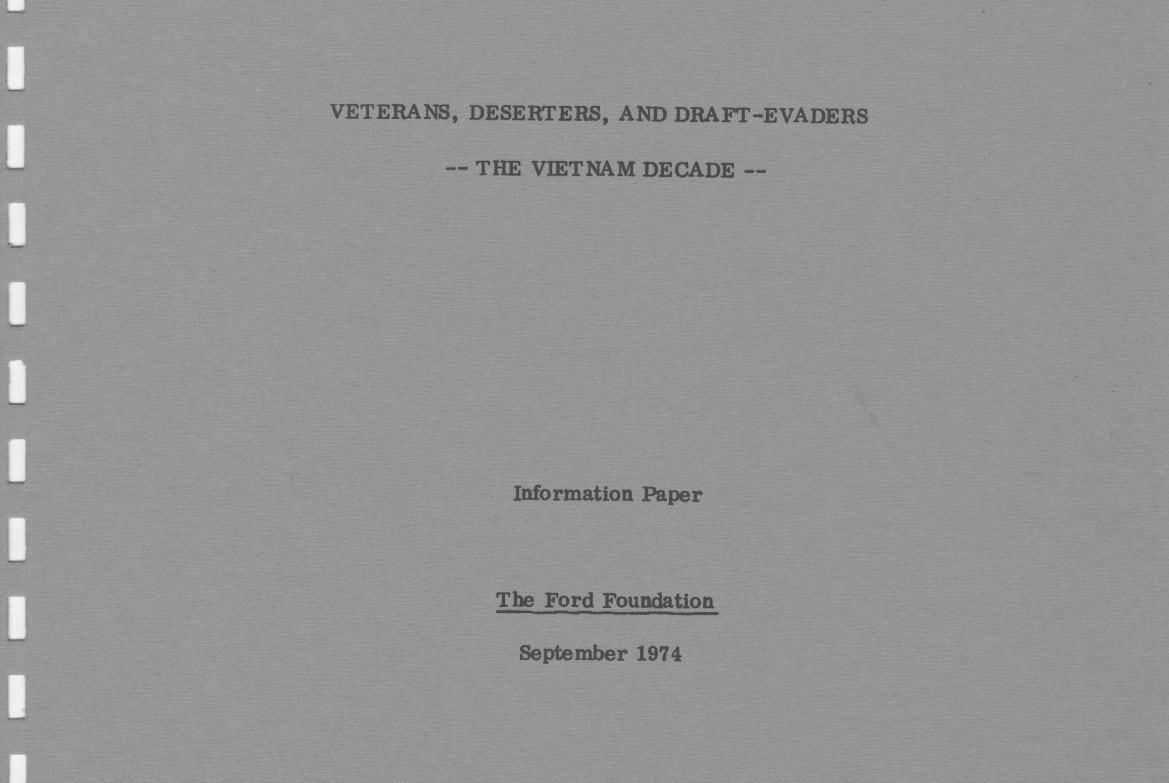
A September 1974 Ford Foundation study on veterans, deserters, and draft evaders reports that between fiscal 1965 and 1973, 495,689 servicemembers deserted the U.S. armed forces. The Army’s desertion rate peaked in 1971 at 73.5 per 1,000 personnel, or 7.35%. Anti-war sentiment in the U.S. was strongest between 1968 and 1971 and gradually declined alongside the withdrawal of troops.
Notably, as with Russia, most AWOL and desertion cases did not occur on the battlefield but in non-combat settings. During the Vietnam War, for example, desertions rarely took place inside Vietnam itself, instead happening mostly outside the combat zone - though recent trends in Russia suggest battlefield departures are becoming more common.
b) World War I: Eastern Front
“Looking further back, but closer geographically, the Russian army during World War I provides an interesting point of view. In 1917, desertions occurred directly on the Eastern Front, with frontline units losing thousands of soldiers daily at peak periods. In 2025, battlefield desertions have risen sharply compared with 2024, though most departures still occur outside active combat zones.
Exact figures for Russian army desertions in World War I are unknown, but available records provide conservative estimates. By March 1, 1917, authorities had detained 195,130 soldiers attempting to leave the front for Russia’s interior. Five months later, that number had climbed to 365,137 - an increase of 170,007 in just half a year.
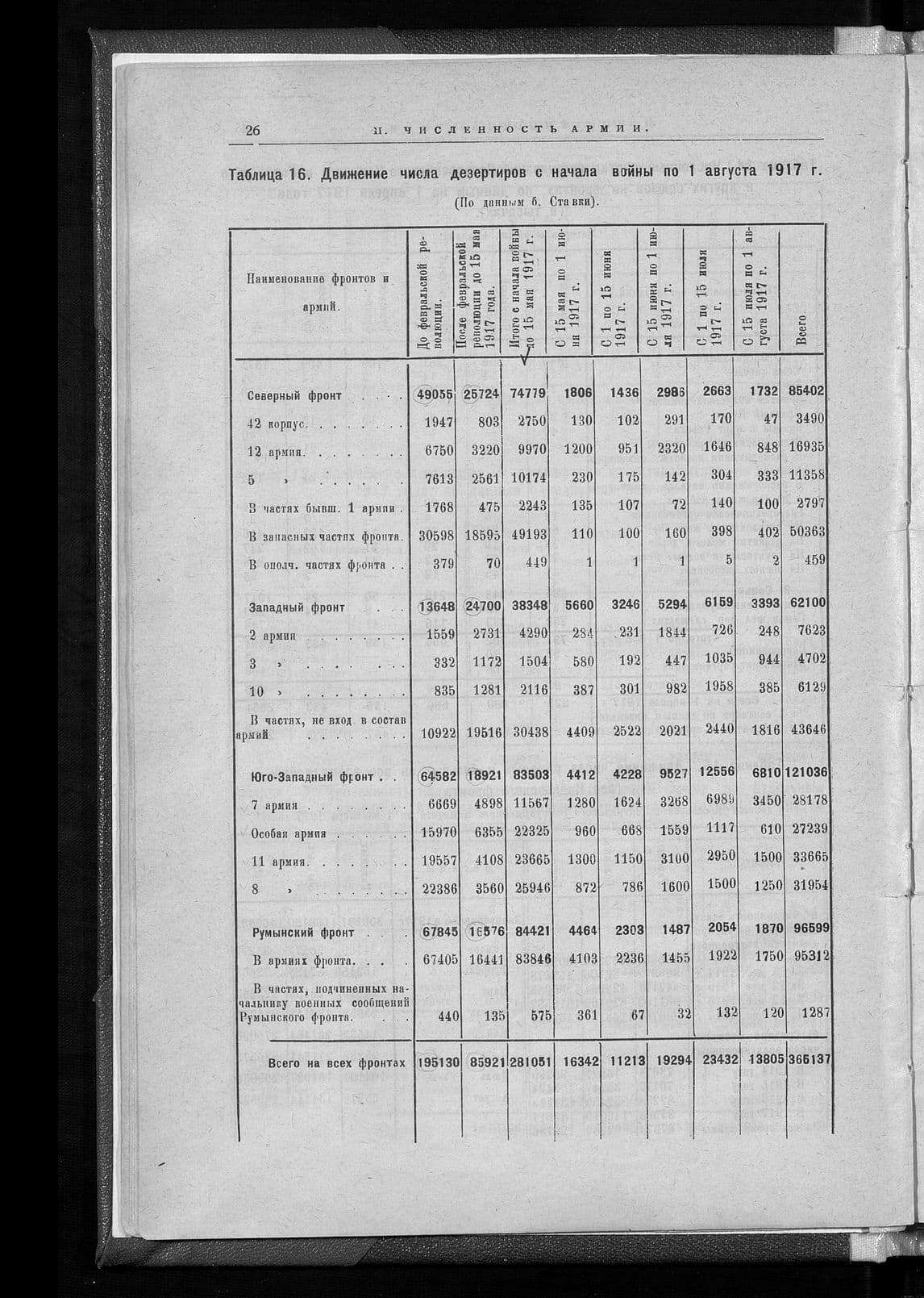
These figures don’t capture the full scale of desertion, only those who were actually detained. Estimates of the uncaught vary, but even assuming half of deserters were apprehended, Russia’s army shed roughly 340,000 men in just five months, or nearly 5% of its seven-million-strong force. By year’s end, the share had climbed into double digits - more than 14%.
If we take Vladimir Putin’s own figure of roughly 700,000 Russian troops deployed in Ukraine, the scale of desertion becomes clearer. Our team estimates that the number of AWOL cases in the first half of 2025 likely reached about 30000 - 35,000. If the pace holds, the total could climb to 70,000 by year’s end - roughly 10% of the entire deployed force, a double-digit rate. If we include the entire force, those in rear bases, logistics inside of Russia, administrative, and other roles, the annual desertion rate could be closer to 6%, rather than 10%.
The projection is based on a straightforward calculation: across multiple units, the AWOL and desertion rate in 2025 has roughly doubled compared with 2024. Assuming the trend continues at this pace, the first half of the year could see around 35,000 desertions, bringing the total for 2025 to approximately 70,000.
While historical comparisons offer some context, our team does not view past wars as precise predictors. Differences in society, the nature of conflict, geopolitical circumstances, and frontline conditions are too great. Still, these comparisons provide a general sense of how desertion trends can evolve in armies under sustained fatigue and declining morale.
In Ukraine, high AWOL and desertion rates are a serious concern, though they sometimes provide a backdoor for soldiers to transfer to another unit. In Russia, the situation is different: desertion almost always means leaving service entirely, with no intention of voluntary returning.
There are no signs yet of an outright collapse, but the strain is clear. Moscow still manages to meet recruitment quotas, though increasingly by drawing on coerced pools: detainees, pre-trial arrestees, and others with scant freedom to refuse. Add in mounting battlefield fatigue, and the quality of Russia’s ranks is slipping. The longer a war drags on, the more fatigued soldiers become - and the more they seek ways to reclaim their lives. Concerns about family, children, and the simple desire for normalcy often drive AWOL and desertion, a factor frequently overlooked when analyzing the numbers. War may dominate the battlefield, but it doesn’t pause life at home.
The numbers remain short of crisis levels. Still, the surge in desertions, even under threats of severe punishment, including reports of extrajudicial executions, underscores a larger problem. What appears contained today could soon grow into a more serious fracture within the army.
This Substack is reader-supported. To receive new posts and support my work, consider becoming a free or paid subscriber.

